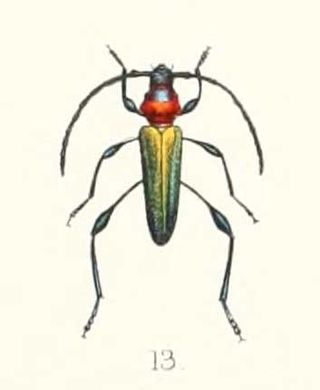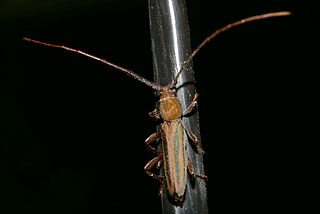
The longhorn beetles (Cerambycidae), also known as long-horned or longicorns, are a large family of beetles, with over 35,000 species described. Most species are characterized by extremely long antennae, which are often as long as or longer than the beetle's body. In various members of the family, however, the antennae are quite short and such species can be difficult to distinguish from related beetle families such as the Chrysomelidae. The scientific name of this beetle family goes back to a figure from Greek mythology: after an argument with nymphs, the shepherd Cerambus was transformed into a large beetle with horns.

Lepturinae, the lepturine beetles, is a subfamily of the longhorn beetle family (Cerambycidae), containing about 150 genera worldwide. This lineage is most diverse in the Northern Hemisphere. Until recently the subfamily Necydalinae was included within the lepturines, but this has been recently recognized as a separate subfamily. Nine tribes are usually recognized today, with a tenth, Caraphiini, created in 2016. A few genera are of uncertain placement within the subfamily.

Cerambycini is a tribe of longhorn beetles classified under the subfamily Cerambycinae.

Agapanthia is a genus of flat-faced longhorn beetle belonging to the family Cerambycidae, subfamily Lamiinae.

Eximia is a genus of round-necked longhorn beetles of the subfamily Cerambycinae.

Callichromatini is a tribe of beetles in the subfamily Cerambycinae, which include the following genera:

Elaphidiini is a tribe of beetles in the subfamily Cerambycinae, historically also often spelled "Elaphidionini".

Graciliini is a tribe of beetles in the subfamily Cerambycinae, containing the following genera:

Trachyderini is a tribe of long-horned beetles in the family Cerambycidae. There are at least 140 genera and 650 described species in Trachyderini.
Crioprosopus is a genus of long-horned beetles in the family Cerambycidae. There are about 13 described species in Crioprosopus.
Deltaspis is a genus of longhorn beetle in the subfamily Cerambycinae, containing the following species:

Xystrocera is a genus of beetles in the subfamily Cerambycinae and the tribe Xystrocerini, with a relatively world-wide distribution.
Callistochroma viridipennis is a species of long-horned beetle in the family Cerambycidae. It was described by Pierre André Latreille in 1811.

Rhopalizus is a genus of round-necked longhorn beetles of the subfamily Cerambycinae.
Tapeina is a genus of Neotropical longhorn beetles in the subfamily Lamiinae. It is the only genus in the tribe Tapeinini.

Rhytiphora is a genus of flat-faced longhorn beetles in the Pteropliini tribe of the subfamily Lamiinae. The genus was first described in 1835 by Jean Guillaume Audinet-Serville.

Chariesthes is a genus of longhorn beetles of the subfamily Lamiinae, containing the following species:

Xystrocerini is a tribe of longhorn beetles in the subfamily Cerambycinae, erected by Blanchard in 1845.
Dychophyiini is a tribe of beetles in the subfamily Cerambycinae, containing the following genera:
Callistochroma is a genus of long-horned beetles in the family Cerambycidae. There are about seven described species in Callistochroma.














